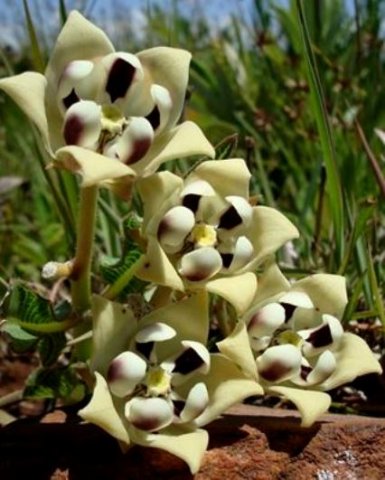Pachycarpus schinzianus

Author: Ivan Lätti
Photographer: Judd Kirkel Welwitch
Pachycarpus schinzianus, commonly known as the lilac pachycarpus, in Afrikaans as bitterwortel (bitter root) and previously scientifically as Asclepias schinzianus and Gomphocarpus schinzianus respectively at different times, is an erect perennial growing from a rootstock to heights around 50 cm. The plant exudes a milky sap.
The short-stalked, simple leaves are large, narrowly lance-shaped, tapering to acutely pointed tips. The blades are rough-textured, and variably hairy. The conspicuous midrib is cream-coloured. Numerous creamy yellow lateral veins ascend slightly to the margins but branch close to it and join each other rather than reaching it. The margins are entire and wavy, cream- or red-rimmed.
The flowers grow in flat-topped umbels from stem-tips. The flat-topped buds are often pinkish to dark red on top. The five short, green sepals are acutely pointed and hairy, in picture veering away from the corolla slightly in their tips. The pale cream, sometimes lilac-tinged corolla is cup-shaped. Its five lobes are pointed and curving out, joined at the base. The corolla is about 3 cm in diameter. The corona lobes are incurved and round-tipped, about white with dark violet bands down their inner surfaces. Flowering happens in spring or late spring, sometimes in summer as well.
The inflated fruit follicles are spindle-shaped, usually solitary as one of the pair tends to abort.
The species distribution is widespread in the northeast of South Africa, not found in the Western Cape, the Eastern Cape or the Northern Cape but occurring in all other provinces and some neighbouring countries as well.
The habitat is stony grassland and is common on the highveld. The habitat population is deemed of least concern early in the twenty first century (Manning, 2009; Van Wyk and Malan, 1997; Germishuizen and Fabian, 1982; iNaturalist; http://redlist.sanbi.org).

